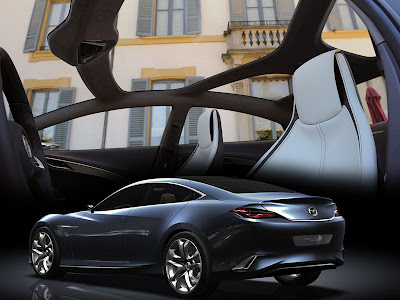Mazda launched the 2010 Shinari sports cars coupe at the Paris Motor Show in early October, a four door concept car that shows the new design. This design as well as to replace the Nagare design. Mazda Shinari Concept represents the profound connection of driver and machine and the beginning of Mazda's latest design theme 'KODO-Soul in Motion'. Shinari exhibits a functional aesthetic that will continue to evolve as Mazda continues to define its next generation of vehicles.
2010 Mazda Sport Cars Coupe Shinari Concept Car
The development of the Shinari Concept was actually a collaboration between three of Mazda’s design centers in Japan, Germany and the United States. Mazda also said it is working to improve the quality level of its interiors for future vehicles. With 2010 Mazda Sport Cars Coupe Shinari Concept Car as the first step, Ikuo Maeda, general manager of Mazda's design division, aims to create original Mazda designs that will be recognized around the world. He summarizes his resolve in the following words:"My goal is to create designs that people can point to proudly and say, 'This is a Mazda design'. There is no need for Mazda to build cars for people who are only concerned with 'style' and 'trends'. Whether working on sports cars or compact cars, I have always worked to create designs that evoke an emotional response in people and I hope to keep doing the same as I remain fully committed to develop designs for people who love and admire cars. It is my personal belief that the only way to create designs that fundamentally connect with people and to create designs they love, is if the people creating them are absolutely passionate about cars and are willing to make that passion a firm policy for design expression.
The Mazda Shinari is a pure design concept model of a four-door, four-seater sport cars coupe which perfectly expresses the 'KODO - Soul of Motion' design theme in a graceful and carefree form. All of Mazda Shinari Concept's body surfaces appear as if constantly undergoing transformation. There is no static shape to be found, as if the car is in perpetual motion. For instance the subtle control of the angle of the upper surface of the side sill, from the front to the rear, results in a form that suggests a flash of speed along the body of the car. Aerodynamic performance was a major priority for Mazda Shinari Concept, and the centre of the lower sections - on both the front and rear bumpers - are designed to optimize the flow of air along the underbody of the car.
2010 Mazda Sport Cars Coupe Shinari Concept Car
The principle of 'dedicated driving ergonomics' is further reflected in the car's next generation Human Machine Interface (HMI). The availability of smaller electronic components has allowed Mazda Shinari Concept's designers to create a floating HMI three-dimensional display; a design element that represents the very latest HMI technology . The system offers three distinct modes: 'Business, Pleasure and Sport'.Yasushi Nakamuta, the chief designer who led the design of the third generation Mazda MX-5, was the first to begin the ideation of the Mazda Shinari Concept: "The challenge for us was to create an innovative new expression for energetic and powerful movement; something that we had never attempted before. We began by developing the design around the image of a predator, as it strikes at its prey, or the stabbing movement in kendo, Japanese fencing, to express the instant where accumulated force is released.
Ikuo Maeda say, "Further, I consider it vitally important to have an awareness of Japanese originality in designing cars for Mazda. This is not merely about incorporating traditional Japanese elements into car design. I believe in reflecting the Japanese spirit in car designs as part of a subconscious practice. So, while I consider where this may lead in the future, my plan is to create cars that will be instantly recognizable as a Mazda, even when viewed at a distance. My ultimate goal is to create a brand presence that car lovers around the world recognize as representing both Mazda originality and Japanese originality. Future Mazda's will move people physically and emotionally - this is 'KODO - Soul of Motion'."



































